Let’s say you didn’t know the outcome of the 2018 Notre Dame – Navy game and I shared the following stats with you:
- Team A 28 first downs
- Team B 14 first downs
- Team A 56% conversion rate on 3rd and 4th down
- Team B 27% conversion rate on 3rd and 4th down
- Team A held the ball for 31:57
- Team B held the ball for 28:03
Which team would you guess is Navy? Past precedent suggests Team A. Better time of possession, double the first downs, better conversion rates on 3rd and 4th down, all of the hallmarks of an efficient triple option team. However, in 2018, the script was flipped and as you likely already figured out, Team A was Notre Dame. This stat line isn’t an anomaly. It’s by design. Since Ian Book became the starting quarterback, the Notre Dame offense has morphed from emphasizing a vertical attack (goal line to goal line) to more of a horizontal attack (sideline to sideline). This has resulted in a offense that is extremely efficient and is able to consistently get positive yards and sustain drives. Let’s take a look at the film and I’ll show you what I mean.
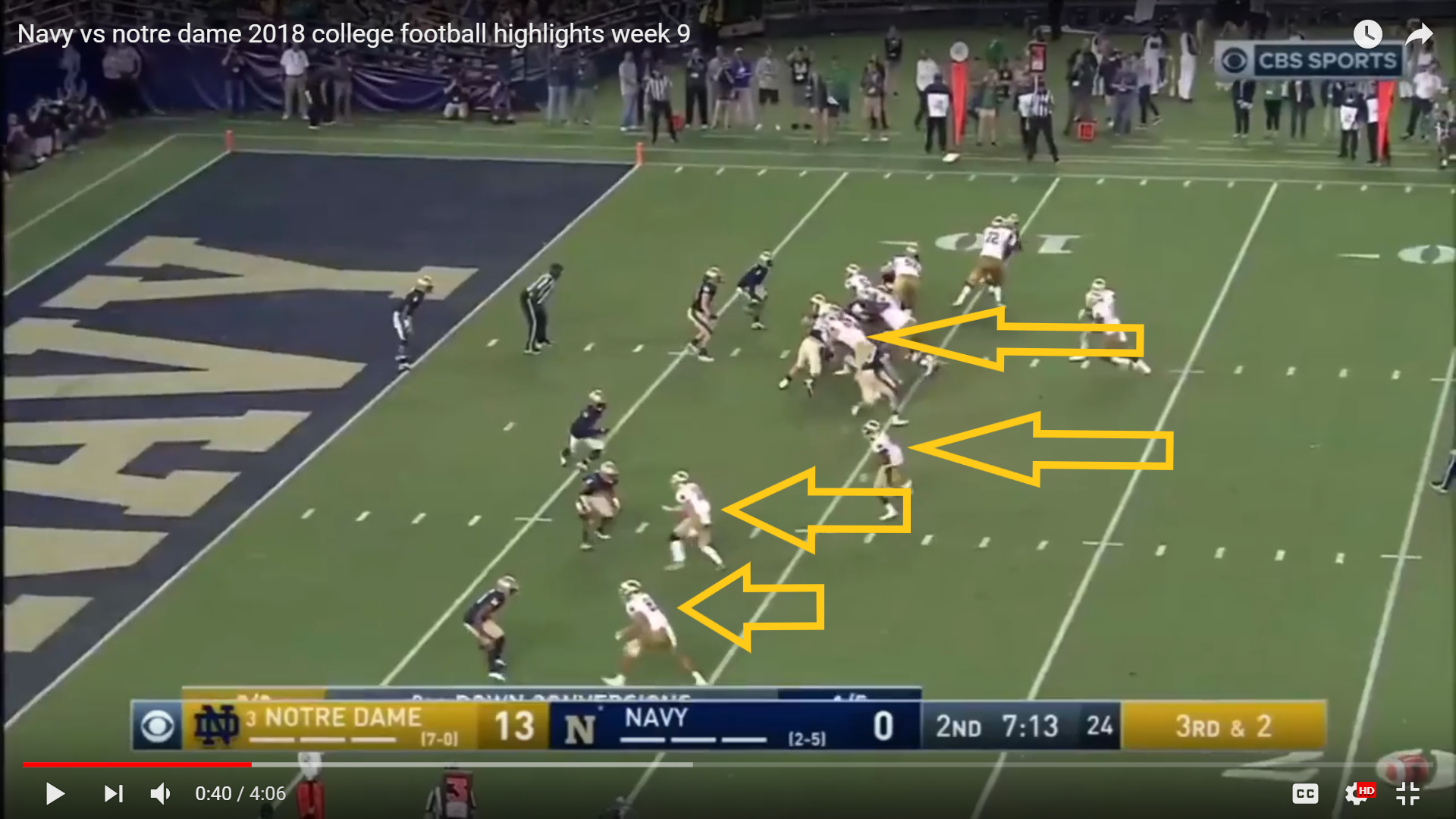
3rd and 2 in the red zone. Notre Dame comes out in a formation that is designed to stretch the defense horizontally (sideline to sideline) with 4 receivers to the wide side of the field (yellow arrows).
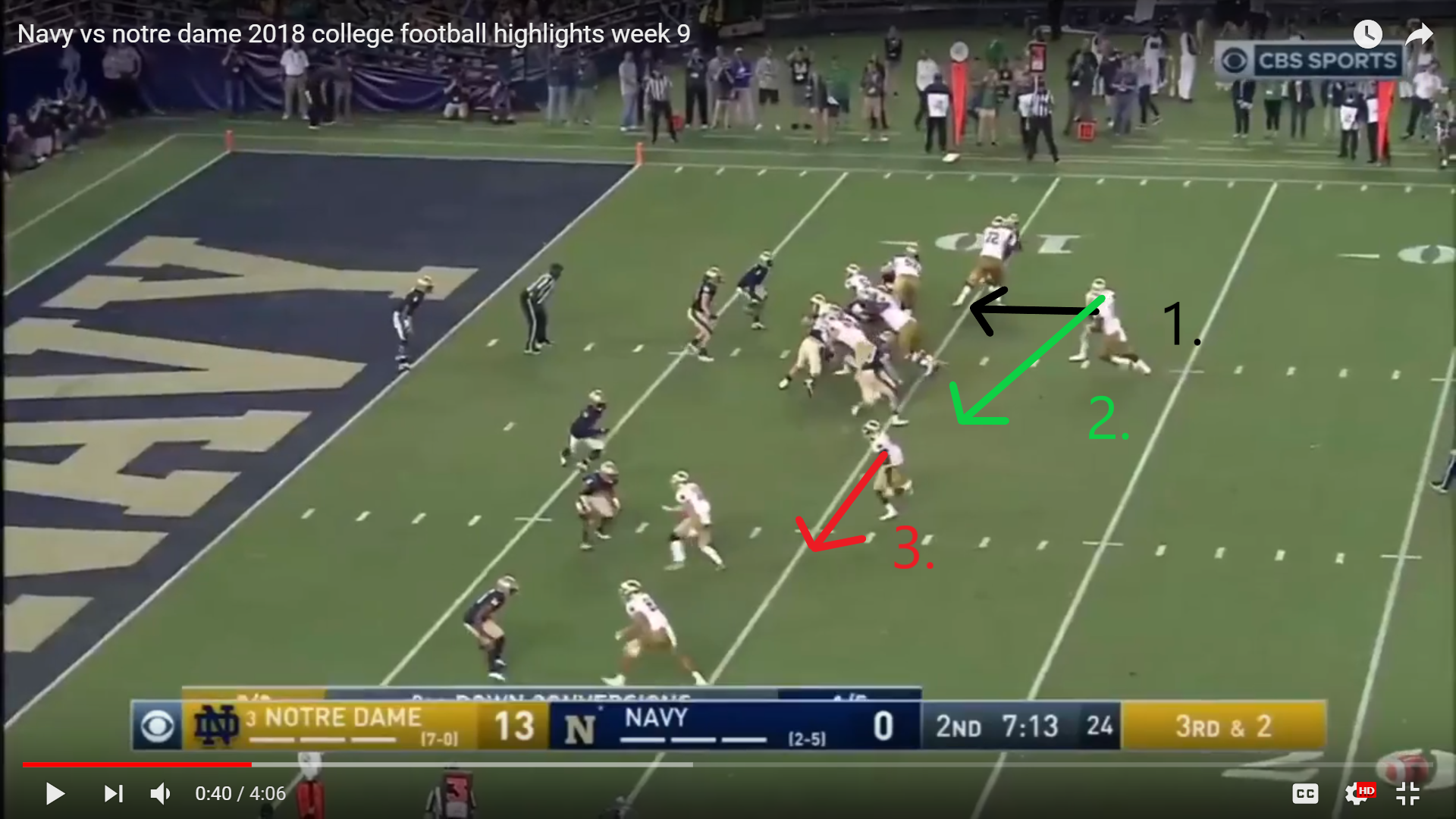
The play design is intended to further stretch the defense towards the sideline. Quarterback Ian Book (# 12) has three options. The first option is to hand the ball to the running back (black arrow, number 1.). The second option is to keep the ball and attack off-tackle (green arrow, number 2.). The third option is to pass the ball to the receiver on the perimeter (red arrow, number 3.). In many ways this is a modified version of Navy’s triple option. It forces the defense to defend the interior, the off-tackle and the perimeter simultaneously.
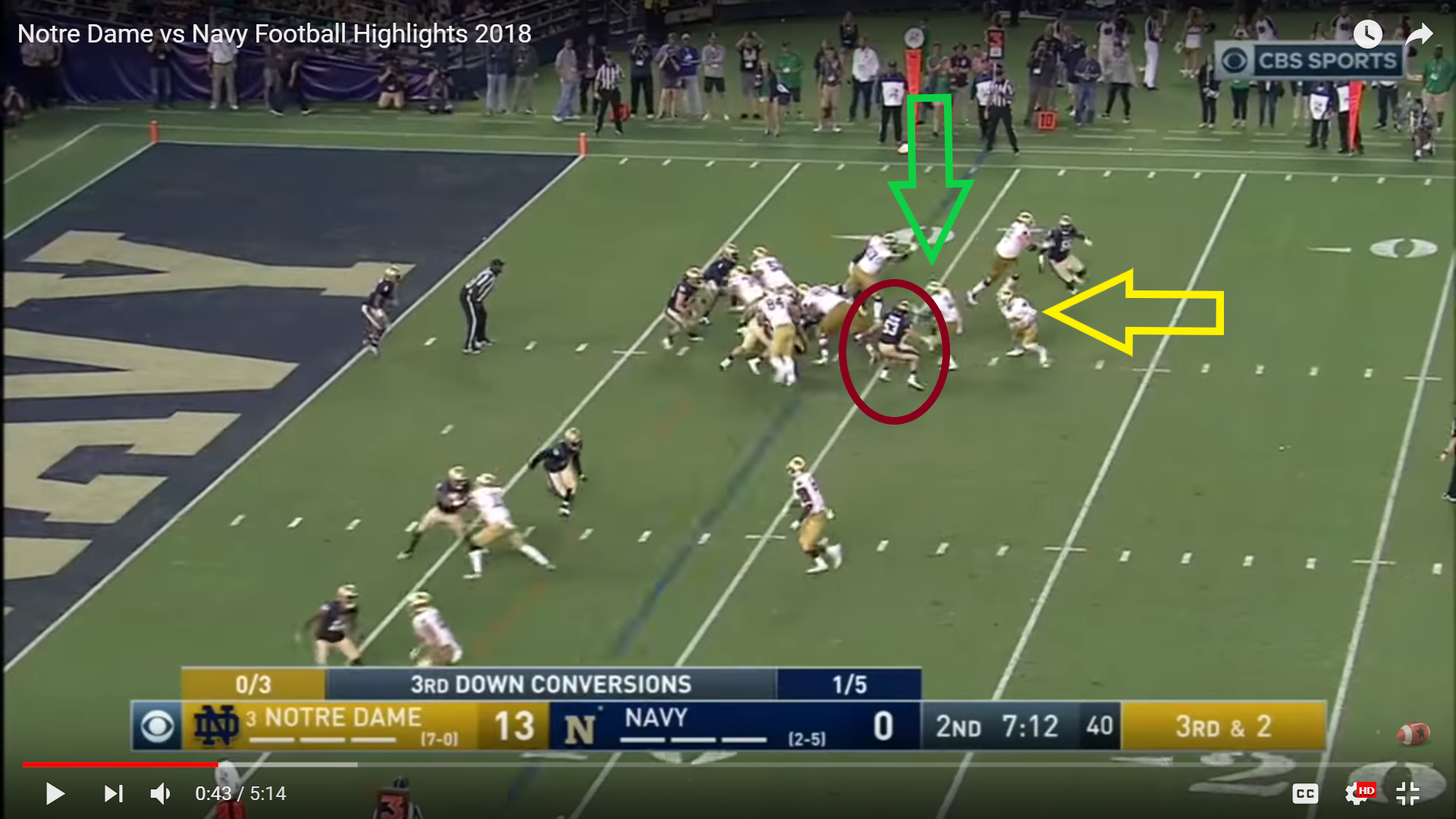
Ian Book (yellow arrow) has just handed the ball off to Dexter Williams (#2, green arrow). You could argue this was a bad decision. The outside linebacker (burgundy circle) was clearly taking away the running back. Consequently, Book probably should have pulled the ball and run to the outside. However, as you can see Book’s fake was enough to cause the outside linebacker to hesitate because he wasn’t sure where the ball was.
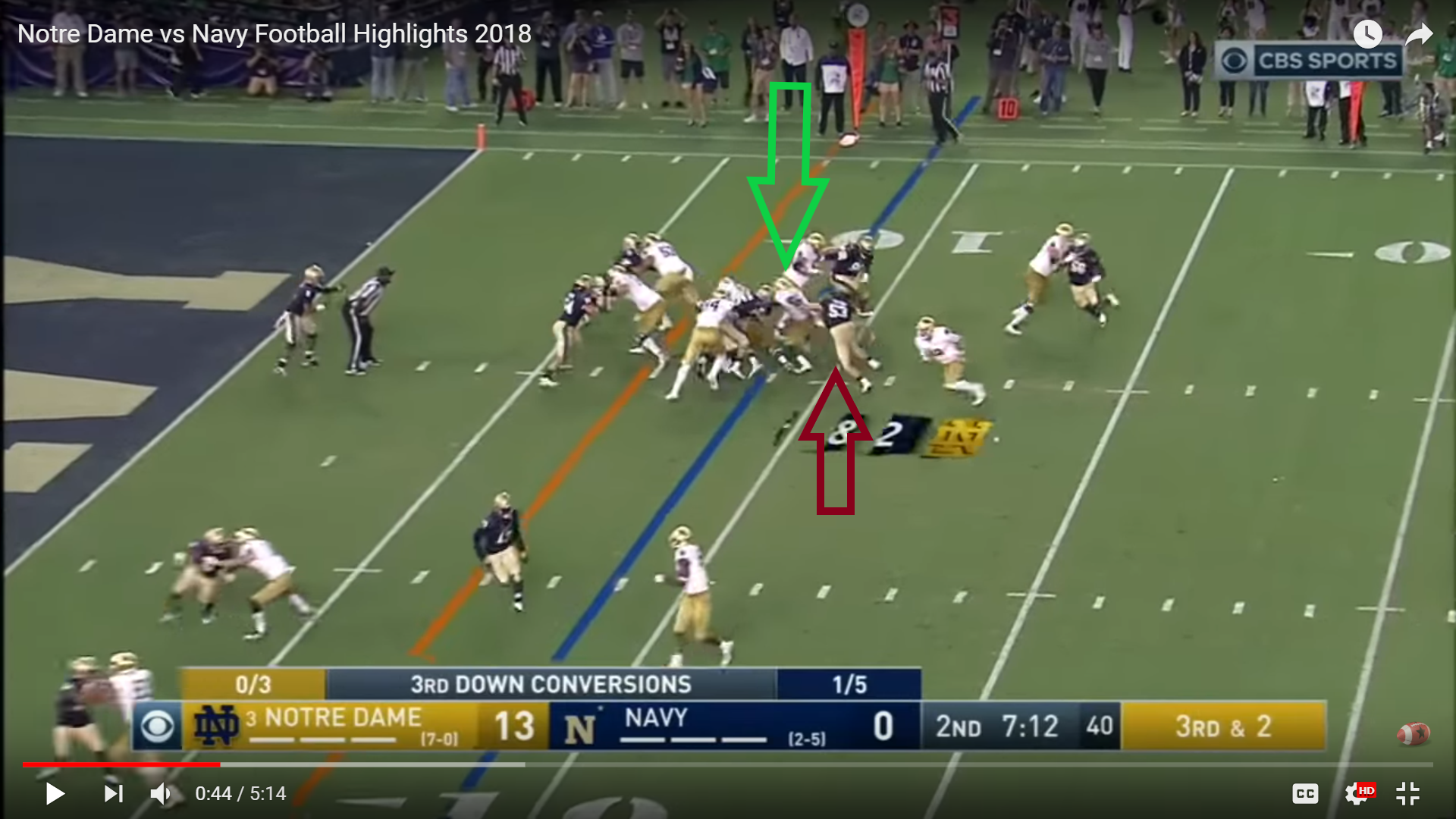
That small hesitation made all the difference. The outside linebacker (burgundy arrow) barely misses the tackle. If he didn’t have to worry about Book carrying the ball to the outside, he almost certainly would have tackled Williams for no gain. Instead Williams had just enough room to sneak through the line (green arrow).
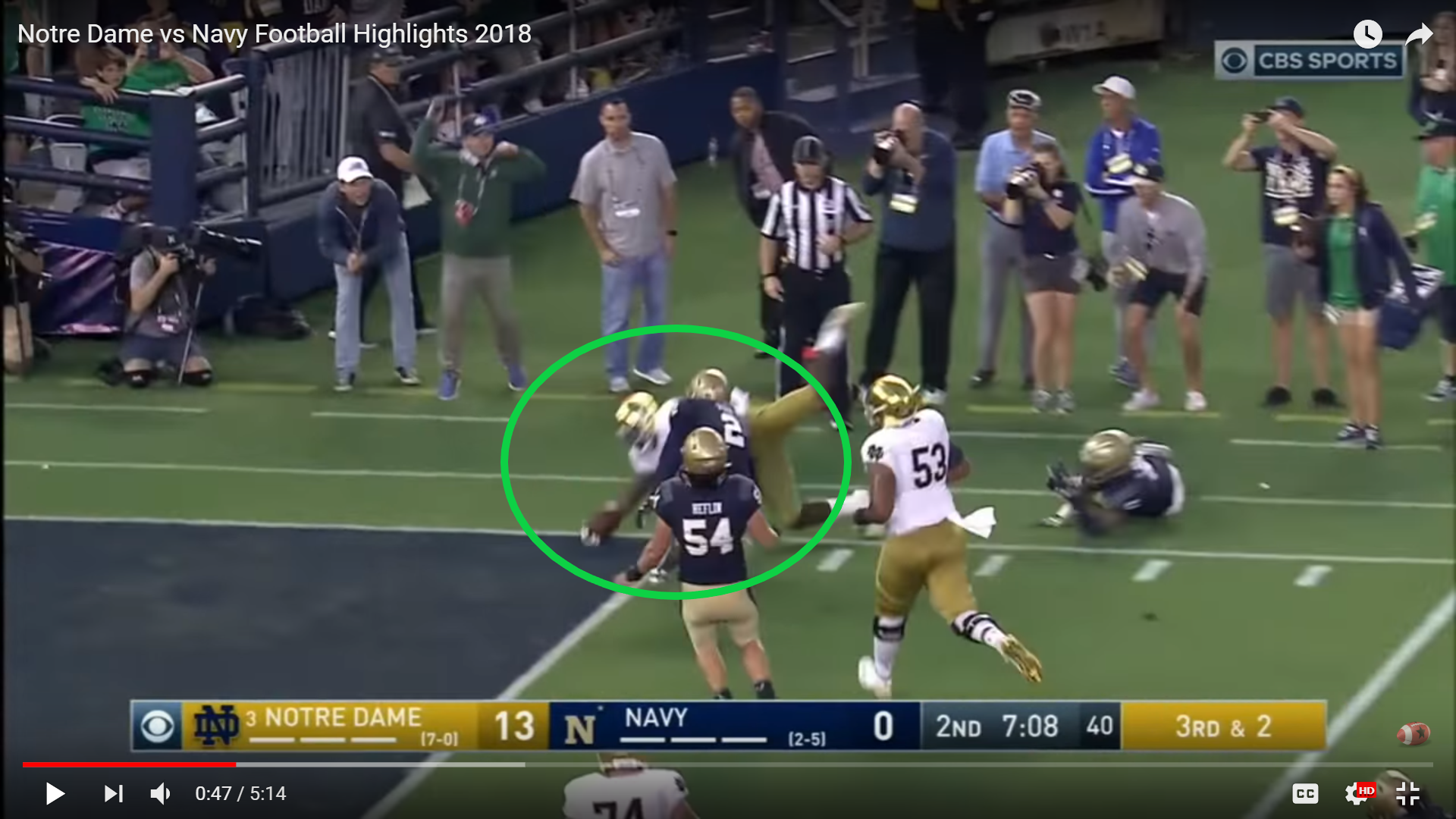
The initial formation stretched the defense towards the sideline; the play design stretched it even further. Stretching the defense horizontally opened up a crease that the Irish were able to exploit vertically. Voila touchdown (green circle).
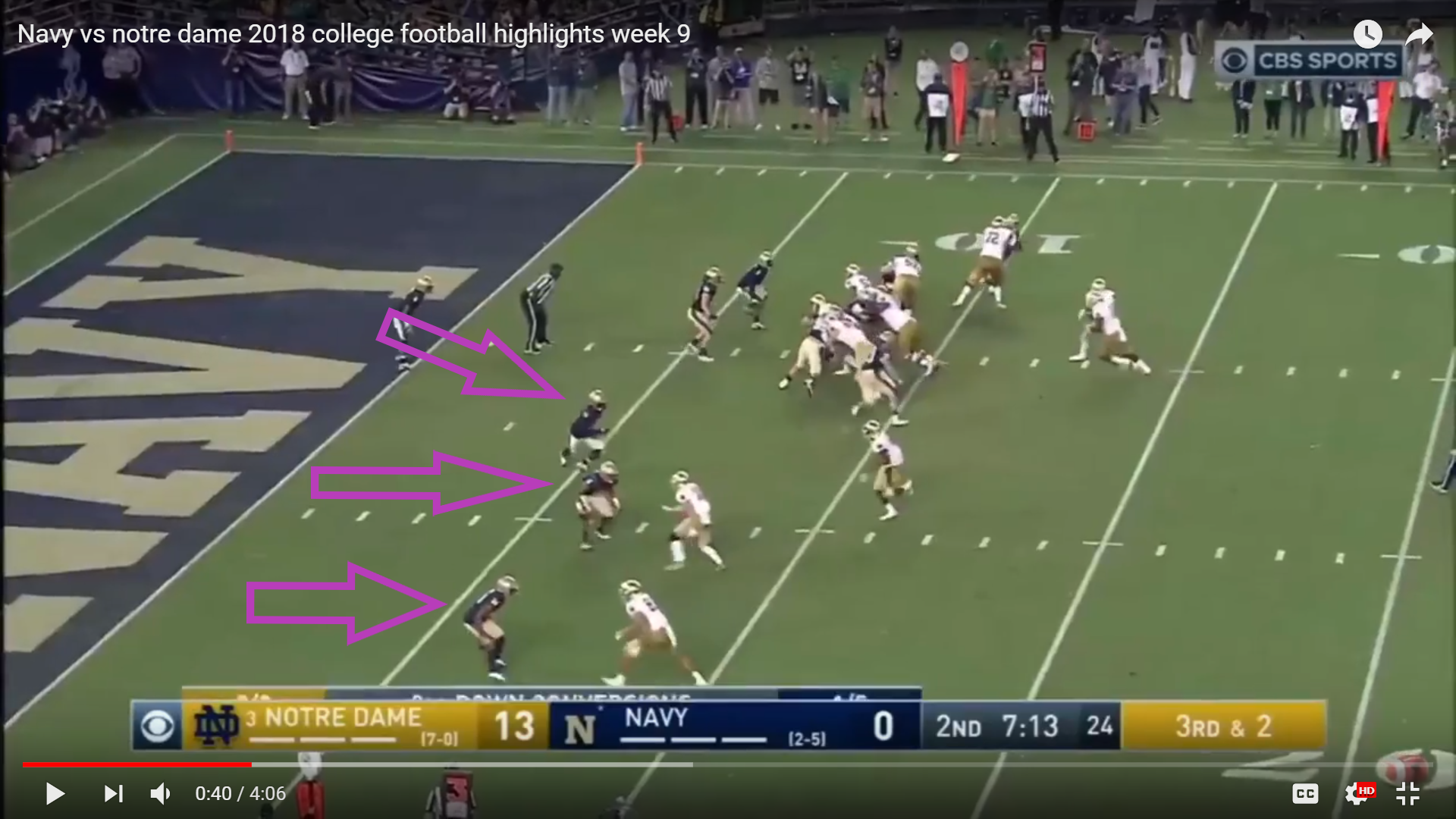
One of the things I’ve been watching closely was how defenses would adjust to the Irish offense under the leadership of Ian Book. Not surprisingly, defenses have started to crowd the line of scrimmage not only to stop the run, but to stop the highly effective perimeter passing game. Crowding the line of scrimmage requires defenses to play tight man coverage. This screen shot is a great example of that. 10 Navy defenders are within 5 yards of the line of scrimmage and all 3 defensive backs are playing tight man coverage (purple arrows). We’ve seen similar defensive approaches from Virginia Tech and Pitt.
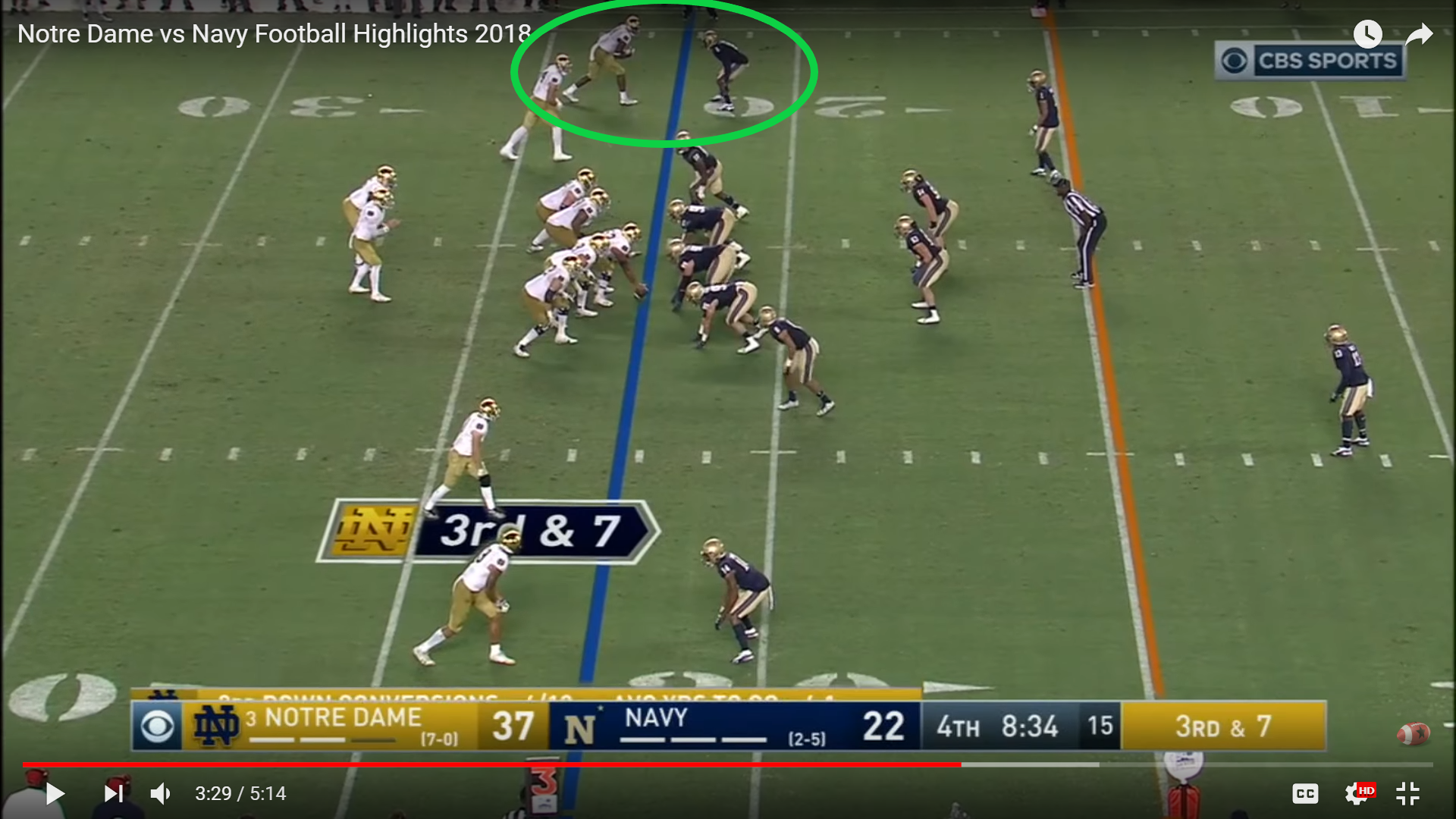
When opposing defenses come up tight, one of the ways the Irish have countered is by going vertical in the passing game. In this case Navy has decided to play tight man coverage (green circle). Let’s see what happens.
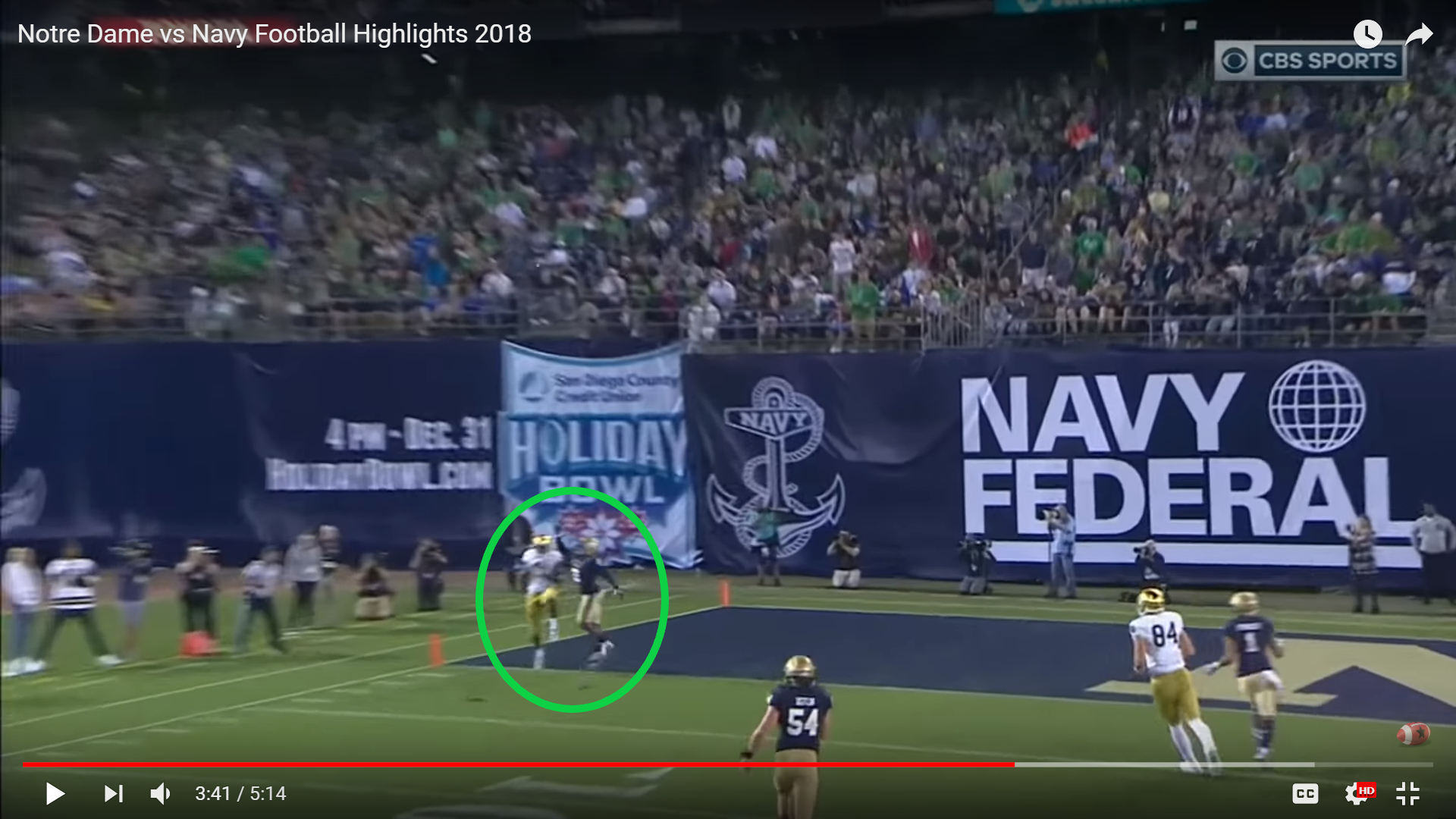
Miles Boykin (# 81) beats the coverage and is in the process of catching a perfectly placed back shoulder fade (green circle) for a touchdown.
Final Thoughts
Since Ian Book became the staring quarterback, Notre Dame’s offense has evolved from one that tried to attack defenses vertically to one that tries to stretch defenses horizontally. We’ve seen greater emphasis placed on shorter, high percentage passes to the perimeter, that may not create as many big plays as downfield passes, but consistently turn into positive yards, first downs and sustained drives. The result has been a metamorphosis from a frustratingly inconsistent offense to a ruthlessly efficient offense.
The next phase in the evolution of the offense is to get vertical a little more consistently. You don’t actually stretch a defense horizontally to get horizontal. You stretch them horizontally to create seams in the defense that you exploit vertically. In other words, there is no point going sideline to sideline if at some point you don’t make progress towards the goal line. As the first play we looked at demonstrates, there is a pretty strong vertical threat in the run game with Dexter Williams. He’s has the potential to take it the distance every time he carries the ball. In my opinion, we need to attack the deep middle portion of the field via the passing game more consistently. Although Miles Boykin won’t run by many corners, he has become a legitimate vertical threat against press coverage with the back shoulder fade. We’ve started to see more slants that hit the middle of the field in recent weeks and I suspect we are going to see more tight ends on seam patterns in the final stretch of the season. Notre Dame’s coaches know that if we can attack the deep middle of the field with the passing game, we’ll be a very difficult team to stop.

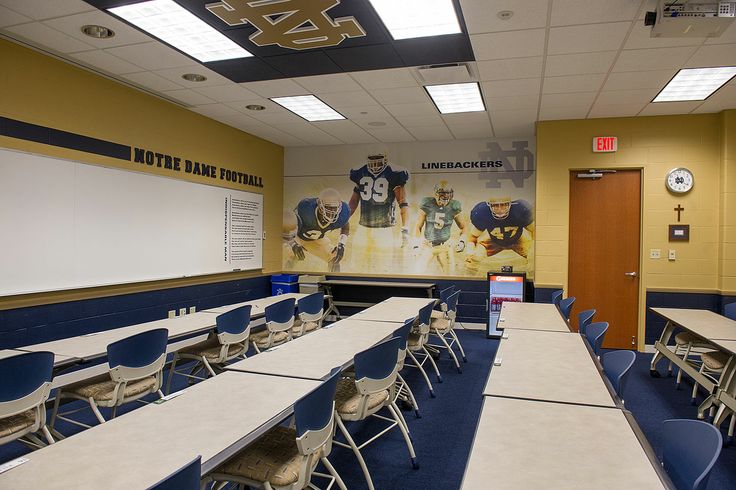
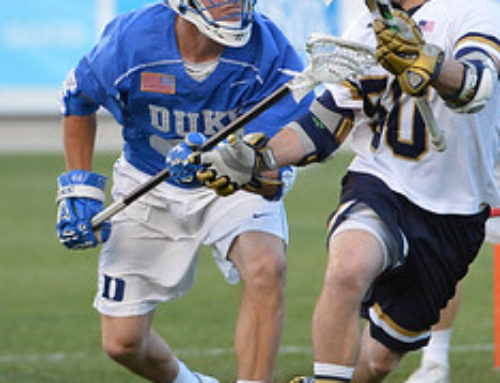
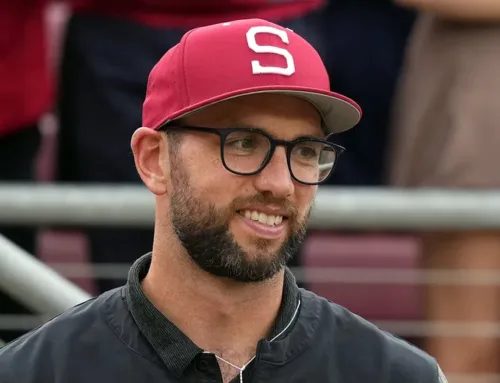
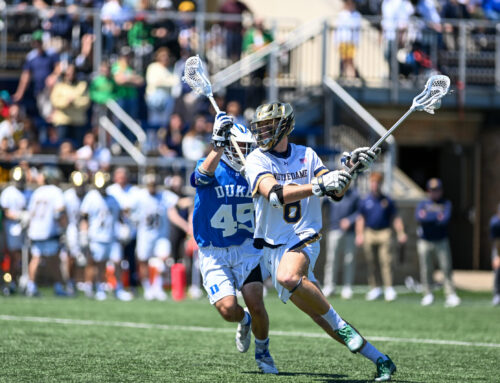
AMONGST our weaponry (against the option) are such diverse elements as: , playing smart assignment defense, a disruptive defensive line, and maximizing your own offensive possessions so they can’t play keep away, which put another way is RUTHLESS EFFICIENCY ON OFFENSE, and a FANATICAL DEVOTION TO KNUTE ROCKNE!
Thanks for playing into my Irish Inquisition bit from the preview comments.
Yeah it’s fun to give Navy a taste of their own medicine
Well heck KG — you may have been a bit tongue in cheek, but the Rock would actually like this scheme if we look at what the shift often did.
Nobody…uhhh…errr.. (expects) expects the ummm….(Irish) I KNOW I KNOW, the Irish errr… (Inquisition) The Irish Inquisition
IRT defenses adjusting to take away high percentage throws – it’s 3rd & 2 from the 9. Wouldn’t most teams be crowding the line and playing tight man? It’s not like they can get beat deep.
It’s a great point. I would agree teams tend to play man in the red zone. However I think I it’s more nuanced than that. I don’t think you always play tight press man, sometimes you will play off and bait the QB to throw something quick because as you said you dont have to worry about getting beat deep so you can jump a route, it’s actually pretty common and a smart place to gamble jumping a route. The other thing is offenses often tend to call plays that beat tight man in that part of big the field. thats why they run a lot of pick and rub routes down there to beat tight man. So defenses will play off to counter that tendency, especially from the 10 yardline. It’s actually pretty easy to start deep in that situatuon and jump short routes from depth. I think we are seeing teams play less zone and less off man coverage on the outside because it they do ND will kill them with the perimeter passing game. if you look at VT and Pitt they played tight man all over the field as well so it seems to be a trend I think the key point is they are playing tight man more than ususal because of what ND does well and especially against this formation because ND tends to run this sort of play out of this formation. I was actually going to show examples of Pitt and VT defending this formation the same way, but simply ran out of time. I’ll be curious to see if this trend continues to the end of the season
I guess…
This might be a better way to frame it, (because I think you raise an intersting point and I alway enjoy the discussion in the comments) do we think Navy (or anyone else) would be as worried about covering Boykin on the pass behind the line of scrimmage to the perimiter if Wimbush was still the QB? I suspect the defensive alignment would be different because the defense wouldn’t be very worried about the perimeter pass. you’d likely see a defender off the line of scrimmage outside of the tackle taking away off tackle run and / or a quick slant.
Again, you are certainly correct about the location in the field and the way defenses adjust, but I think we all agree the offense has changed with Book at QB and as a result defenses have had to change what they are doing.
I was 100% being jocular in my “I guess…” You provided a well-thought out explanation of your original premise
….Although, “do we think Navy (or anyone else) would be as worried about covering Boykin on the pass behind the line of scrimmage to the perimiter if Wimbush was still the QB?”
No. But would they still not play tighter to the line in respect to BW’s running ability? That is, more afraid of getting burnt by the QB’s feet rather than his arm? (I am now truly asking, rather than attempting a discussion.)
Lol got it! Like I say, I really think the point you raise is intersting and this is a great question as well. You see the Navy defender chasing Boykin to the outside, I’m not sure id have him attack Boykin so aggressively for exactly the reason you stated, he’s vacating the area that Wimbush is likely going to run to or throw the slant too and he’s not even looking at the QB. You could still play tight to the line, but I wouldnt chase Boykin. From a run support perspective I wouldn’t be play the DBs close to the LoS because I like them to be second wave against the run (front 7 being the first wave) I find they tend to get caught up in allof the traffic of you play them too close. But that’s really is a matter of preference.
TE seam, TE seam, my kingdom for a TE seam. Can we just sub out a TE seam route in place of every TE flat route, please. The TE’s get nowhere running laterally on those. If we start to hit the TE’s vertically, look out. We will be cooking with gas brother. And I mean, it’s a good way of stretching defenses with throws that don’t take tremendous arm strength. Throwing it straight down the middle of the field 20 yards is a shorter distance than throwing it half way across the field 10 yards down field. Take the square root of 27 squared plus 10 squared. It’s called the platonic theory. Deal with it guys. Math. Anyway I know there’s more traffic down the middle of the field and MLBs and safetys and whatnot, but can we please feature Kmet doing what he did on 4th down vs. Stanford? Or Alize in space in the middle of the field. Chip Long why you no run TE seam?
Actually — I think BK in his presser yesterday kind of tangentially alluded to this in answering the question about the TEs…
“. Tight end production, been able to rely on two or three tight ends. Your evaluation of that group through eight games?
BRIAN KELLY: I think each one of them does some things that certainly strengthen our offensive production. From catching the football vertically, they’re long guys. One of the frustrations that they all have is they’re getting cut tackled. We have to create situations where we’ve got to get them stacked with a receiver over the top of them. If you want to come down and cut tackle them, we have an option over the top of them. They got a little frustrated in the last game.
I heard that but did not really understand what he was talking about. Is the “cut tackling” mean that the D linemen are hitting their legs, cutting them down, or does it mean that after they have caught the ball, the D backs are tackling them too easy (by diving at their legs????) Is the option to throw a seam route over the middle????
Well More Noise, mon ami, what has he been waiting for? I’ve been saying this for weeks. Maybe its Mike Bertschs fault. Still I would expect CBK to be following my 18s comments personally and not delegating to Dir. of FB Ops.
Well, heck yes… maybe you should also have him follow you on Treeter or whatever that thing is!
Saving it for the ‘ship?
Hmmm… so they just bust middle routes to the TEs out for the ship to the tune of like 20 receptions for 240 yards and 3 TDs? Ok I’ll take it. I like where your head is at HCHog. Like it s lot actually.
I think when you stretch defenses out by throwing those short pass to The outside you get less traffic in the middle. Hopefully that opens up the seam pass for us. I’d love to see a tight end down the middle for a big gain
Right? I mean who isn’t in favor of seeing Cole Kmet do more of what he did to Stanford on that 4th down?
Wait, you mean all those girls in college were lying when they told me that Platonic Theory was the idea that relationships are just so much better if there’s no physical intimacy?
Yeah man that’s not the platonic theory. That’s the hippocratic oath. You were lied to.
This answer is worth my 18S subscription fee – double even!!
Great analysis! It reminded me of an article 538 wrote about Gurley and the Rams where they showed that it is easier to run the ball with spreading the defense out. So the Rams run the ball almost entirely from a 3 wr 1 rb look (in fact they run their whole offense from that formation).
Thanks Irishchamp Yes he it’s almost counter intuitive, but it certainly makes sense. I’ve run the fly offense in the past and it is designed to stretch defenses horizontally and then attack vertically. A lot of spread teams use formation to spread the defense horizontally and then find seams. Sure makes it hard to play team defense that way, you really need to tackle well in space
Great analysis! Thanks!
No problem, happy to do them!
Thanks Larz. Amateur rules question: why was it legal for Hainsey to be uncovered at the end of the line?
It looks like the TE on the left side is covered by Finke. So Hainsey is functionally a TE, and the TE is functionally an ineligible tackle. This is basically a tackle eligible formation.
I’ve never had a great grasp of American formation rules. In Canada and the NFL I believe, you have to have an eligible number on each side of the line. I think NCAA rules don’t require you’ve to have eligible numbers on each side of the line but you have to have 7 on the LOS. I stand to be corrected on that!
In the NFL every eligible position has to have an eligible number, and every ineligible position has to have an ineligible number.
If an ineligible number lines up eligible, or eligible lines up ineligible, both perfectly acceptable (to everyone other than John Harbaugh), they have to declare that to the officials, who will tell the other team.
Not sure if NCAA is exactly the same as NFL, and jersey and numbering rules are different between the two, but I’d guess they are fairly similar in this.
In NCAA, you do not have to have an eligible number line up on the end of the line, but he also cannot report as “Tackle Eligible” like you can in the NFL unless you literally give the player a new jersey with an eligible number on it. So in this case, Hainsey was fine being there, but he couldn’t have checked in as an eligible pass catcher.
Good info!
I’ll answer everyone here, but reply to you directly.
Your specific question: “Why is it legal for Hainsey to be uncovered…”
Answer: Because an ineligible being covered up is only a requirement for SCRIMMAGE KICKS. And this only applies when you are talking about players playing the line with the numbering exception rule. In any normal scrimmage formation, the offense has to follow only 4 requirements:
1. All players must be in-bounds(you cant have 10, snap the ball and send #11 from the SL)
2. All players must either be a lineman or a back(these are defined in Rule 2)
3. At least 5 players 50-79 must be on the line
4. No more than 4 players may be backs
Larz said “7 on the LOS” and that is incorrect for the NCAA. That is an NFL rule. It’s the same thing, basically but the NCAA says only 4 in the backfield.
MickeyB was correct in answering NDJB with the “reporting as eligible.” You cant do that in the NCAA, that’s a pro thing.
I’ll take this a step further and explain the WHY of this rule. Why does it matter if a player is “covered up” or not? Basically it prevents the offense from tricking the D into committing a defender for a player that is not an eligible pass catcher. What you see sometimes is a TE #84 line up on one side of the ball on the line, but #81, a WR lines up split wide ALSO on the line. #81 is the end, so he is eligible. In this formation, the TE is really not a TE because he’s ineligible by position but he’s eligible by number. This may trick the defense so they put a LB to cover him in case he goes out for a pass. But the rules prevent him from doing this. He would be an ineligible player downfield just like an interior lineman numbered 50-79. If defenses are paying attention and they see #81 is on the line, they shouldn’t cover #84 out of this formation. In the formation where Hainsey is #72 but on the end of the line, he’s ineligible by NUMBER and can NEVER go downfield for a pass, so it’s not a disadvantage for the defense for him to be on the end of the line. They already know he’s staying in to block. He has to, by rule.
Thanks Clearwall!
Thanks!
If I’m trying to slow ND, I’d be thinking very seriously about playing a single high safety zone defense with press coverage on the outside. Yes, it’s incredibly high risk. But you have to find a way to cut down on Book’s easy throws into the flat, which are a guaranteed 5 yard gain every time without opening up the box for Dex to get a full steam burst up the middle.
Of course, I’m guessing most teams have only really practiced this alignment in goal line situations, so that might be asking too much of them.
Quenton Nelson is the first ever guard to win NFL Rookie of the Month honors. He’s pretty good.
Still has a ways to go to live up to Zack Martin. First rookie OL to be named first team All Pro
The Ole Miss appeal just concluded, their punishment for years (the case covered periods back to 2010) of violations including providing cash to potential recruits, providing cash to the families of current players, arranging for car “loans” for players, boosters providing goods and meals to players, altering recorded ACT scores for athletes, and recruiting contact violations is a one year bowl ban.
Un-F@$&-ing believable. And they want us to vacate wins. NCAA is dead to us. They have lost ND. To their ultimate detriment.
I look forward to our dominant NAIA championships!